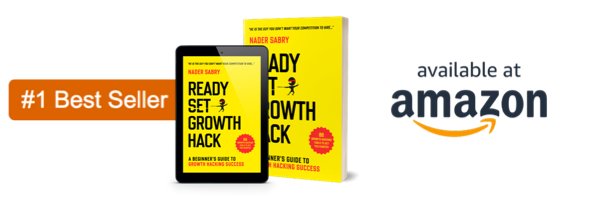Five Trends in 2021 that will help you greatly prosper
The rise of micro-opportunities and how it will change everything you’re going to do in 2021 and beyond.
Nader Sabry is a strategist, innovator, and entrepreneur in NASA space tech, government, and health/wellness. Has raised $20m directly /+$100m indirectly for startups and is a bestselling author of “Ready Set growth Hack: A beginners guide to growth hacking success” which is a growth blueprint for organizations to achieve 10x growth.
Five trends in 2021: Forward to basics, a concept I introduced at the beginning of the pandemic took many people by surprise. Why that was, is that we got so used to mega-movements and the sexiness of technology that we are on an unstoppable ride forward. What the pandemic has taught us is three main things:
- We are going back to basics,
- We are equipped with many tools, and
- We are going to make more meaning
So how does all this relate to forward to basics? Essentially, when in uncertain times, there are two primary things you do. One is to stop and reflect so you can observe to get visibility. The second thing is going back to basics. We go back to basics because it gives us a fresh perspective on how to solve problems. Here is the GOOD NEWS, we are not going backwards but rather forward. We are going forward since we have many tools, techniques, and technologies to accelerate our ability to start from basics.
Forward to basics
We will be going back to the basics, the building blocks that keep us alive and moving, but the big secret is that we have many great things to help us. Those great things are techniques, technologies, communities, and mindset to start from the basics by moving forward quickly.
The basic building blocks are what make us who we are. The basics are what keep us alive and moving. Food, shelter, clothes, health, and community. Those very basics are what keep us going, but how we can move forward with them is like this:
- Food, we have the technology to make better food safely, quickly, and healthier,
- Shelter, we have techniques to build and operate efficient, clean, and safe homes,
- Clothes, we have the materials to keep warm/cold and ensure durability,
- Health, we have the innovations to detect, diagnose and treat a low cost, and
- Community, we have the tools to keep us connected and thriving
Age of micro-actions and massive-impact
Keeping in the context of moving forward to basics, we have to simplify. Our lives have become over-complicated at the benefit of those who make complexity their tool to monetize. This will not work moving forward. So we are in the era of micro. The age of micro is simplification of what we do.
Remember, complexity is only a whole bunch of simple parts that are not organized. When we organize all those small parts, we can see complexity for what it is. When that happens, we can now focus on small pieces that have a massive impact. Welcome to the micro-era, where we will be working within a simpler environment with tools that will accelerate our ability to make a living and live a more fulfilling life.
Five big micro-opportunities in 2021 and beyond
Complexity removed, simplicity unleashed — small actions and significant impact is where we are going. The overly complex structures of organizations, management, and technology are about to get hit hard. Although we see technologies like artificial intelligence rising and taking over significant parts of our lives, this is part of why we will have a better future. Although artificial intelligence has its challenges, its benefits greatly outweigh the problems it brings.
Five significant opportunities are arising and in a specific sequence too. This sequence is based on how we develop and survive in the coming times:
- Micro-skills,
- Micro-tasks,
- Micro-communities,
- Micro-income, and
- Micro-health
Micro-skills in 2021 and moving forward
Having many skills is essential, but naturally, there will be tasks that you are better at. Typically, the reason why you become multi-skilled is survival by being more competitive. That is because organizations want to get more out of a single person. This does make sense, but it also has its challenges like focus, quality, life-balance, etc.
That said, having many different skills is a good thing, but being able to hone in on a few that are your superpowers is essential. Before, you did not do this for a few reasons. The primary drive has been that focusing on only a single or few skills would not be enough to live on.
The good news is that it has changed. Since the volume of demand can be filtered and focused on using online platforms, you now have the demand that can justify your efforts. This doesn’t mean less competition but rather a better set of possible clients who would be very focused and have an extremely high interest in what you have to offer. Getting honed in and developing core skills that have high-volume is the name of the game. For example, if you’re a logo designer, and that is all you do, don’t stretch out to branding identity; focus on that one part that works well for you.
Here are some insights from Vanshika Mehta, a successful brand storyteller and communications specialist helping entrepreneurs and professionals alike:
I believe that we have been moving into a skill-based economy more and more, as competition to be the best at what we do has risen. People for long have said, hire for skill retain for talent. That is so true, and it’s becoming the new reality as information has now been democratized and is easily accessible. The internet is indeed a wonderful place!
- Want to learn Digital Marketing? – Take a course on Coursera
- Want to build a personal brand? Learn and build on Linkedin
- Want to learn just one niche topic? – Go to YouTube
This was not the case just about ten years ago. Formal education is soon going to see its way out of the door. We are in a skill-based economy now where agility and the ability to pick up new skills is quintessential to your personal and career success.
Since I began working independently, the two skills I needed a lot more were time management and critical thinking. This has enabled me to work effectively for the last ten months (not a huge time span in the greater scheme of things) but have allowed me to be the best at what I do.
At the start, I struggled because I kept confined to a 9-5 mindset, which held me back massively. Today, I’m thriving as I have developed my time management and critical thinking skills. I also paid close attention to client needs to handle clients differently, which exposed me to different opportunities. Today, I have a 70K+ following on Linkedin of highly networked entrepreneurs, investors, freelancers, and more.
I would encourage every single person to focus on building skills that will help you achieve your successes. It’s no longer about who can get the job done; it’s about who can get the job done – better and Become your competitive advantage.
Although clients might want more, they are better off getting experts in small-tasks than getting mediocre deliverables. This applies across many other fields as well. It’s about finding the right mix that works for you.
Micro-tasks in 2021 and beyond
Project management is at its end – large undertakings that would override much of middle management’s efforts. It doesn’t work, why it’s costly, ineffective, and there are tools to replace this complexity and solve these shortcomings.
The gig economy has proven this with such tools as Fiverr.com, Upwork.com, freelancer.com, and the likes of having enabled cost-effective, high quality, and quick execution of tasks. These platforms have been using artificial intelligence to create a superstructure that does the following:
- Structured – streamline outcomes that have a straightforward result with a relatively small deviation, and
- Unstructured tasks – subjective tasks that need more rigor to ensure effective execution
The challenge where artificial intelligence plays an important role is in the unstructured tasks. Artificial intelligence gives buyers and sellers the power to pinpoint their requirements, manage the process, and give them collaborative tools that enhance communications. Communications is where the most extensive form of failure happens. Hence these tools create a dynamic yet structured way to manage communications avoiding misunderstandings, miscalculations, and misrepresentations.
Insights from Ivna Curi, the founder of AssertiveWay.com, dedicated to empowering professionals to be confident and thrive in the workplace:
If you have a pleasant experience with Fiverr or Upwork, it will save you a lot of time. If you have a poor experience, you’ll become frustrated and waste resources. The difference between an excellent versus poor experience depends on how significant your interaction with the provider is. The reality is that you’ll often deal with people from other countries, different perspectives and experiences. And like any new hire, you need to set quality expectations ahead of time, clearly specify what you want, and agree on the process for review and approvals. That way, both parties will be satisfied with the interaction. The buyer will get excellent service and have a trusted provider to work with in the future. The seller will have a repeat customer and a higher tip. It’s a win-win. One last thing always starts on a small project to test the waters before taking on larger and more risky projects.
Getting organized to manage micro-tasks is the single most important success factor. That includes growth hacks like onboarding techniques, structured scoping, and add-ons that enhance the overall results.
Micro-communities in 2021 and the future
Once you have honed into your micro-skills and tasks, now it’s about micro-communities. Micro-communities serve a few important purposes:
- Skill-building – developing new skills,
- Skill-enhancement – improve your existing skills,
- Task-collaboration – working with others to improve delivery, and
- Task-delivery – others working with you to deliver the final product
Honing your skills will be the number one reason you’re connecting into micro-communities. Whether you develop, enhance, or collaborate with your skills, being in the right micro-community is crucial.
Marc Jarrett, a disruptor in the virtual networking space, offers vital advice on micro-communities and says, “I take a long-tail approach when it comes to community building. The more specialized the subject is, the better. I know nothing about BioTech. But what I DO know is that when you have two or more people in the same virtual room who share an interest in it, you are more likely to have a meeting of minds, leading to a friendship and a possible transaction.” He also added that “ Taking an interest in people is critical and encourages them to practice the ORS (Open, Random, Supportive) mindset to which I subscribe. It’s the antithesis of corporate thinking, which tends to be closed and secretive.”
Micro-communities will continue to rise but will become a lot more refined in their activities. The future of these micro-communities will have the challenge of getting participants to collaborate with others. Even minimal forms of collaboration with like-minded people can go a long way.
Micro-income in 2021 moving upwards
This is about several income streams using your micro-skills delivered as micro-tasks and using micro-communities to leverage your income creation possibilities. This is about finding as many different sources, both passive and active. Passives are digital assets you can create like online-courses, templates, ebooks, etc. Active income is using your skills and time to earn income.
I need to stop here and point out that the get-rich-quick schemes where passive income is a grand promise to solve all your problems aren’t true. This is about working hard and working smart; that is the reality. Now, having a mix of passive and active income streams is the name of the game. Consider it like this five central transition point when developing your micro-income (the breakdown of income source by active vs. passive):
- 90/10 – Majority active with a light-touch on passive income,
- 60/40 – Majority active with a progressive drive towards passive income,
- 50/50 – Balanced split between both active and passive equally,
- 40/60 – Majority passive where you’re transitioning out of active income, and
- 10/90 – Majority passive where your active income is
Mario Nawfal, a Serial entrepreneur whos, built many multi-million dollar businesses both off and online, gives unique insights into passive vs. active income generation:
I look at two possibilities in seeking a passive income: Either seek a passive income from the onset (common examples include rental, investing, lending…) or migrate an active income into a passive one (systematizing your business to make yourself obsolete, migrating a service-based business into a software).
The former is more comfortable to achieve. Pursue safer options (investing in indexes rather than high-risk assets such as crypto) and ignore get-rich-quick schemes as they are mathematically and statistically are a scam.
The latter, shifting an active income into a passive one, is the holy grail everyone should aim to achieve; however, it’s not a simple process. It requires the balance of various aspects, including delegation, systematization, feedback loops, patience, and persistence. Examples include hiring others to replace you as a consultant or pivoting your consulting business into an info product.
The idea of a traditional job or setting up a conventional business is long gone. Corporate registry and competitive regulations will need to adjust to this new environment. Regulatory challenges will revolve around protecting all parties quickly and cost-effectively, especially when it comes to intellectual property.
Micro-health in 2021 and onwards
Getting focused on a life-work balance in a virtual world. The first challenge the pandemic has presented has been about going 100% virtual. As a result, work has taken over even more time and created even more stress. Finding that unique balance is where we now face the most significant health challenges of 2021 onwards. A few focal areas are:
- Support groups – reminders and accountability can be more vital than you might think in ensuring consistency, so having a group to help with that is essential,
- Health education – keeping up to date with the latest self-healing techniques, technologies and approach is essential to find what works best for you, and
- Meditation – creating headspace and a time to reflect and refresh to take a much clearer and concise perspective while being balanced in your approach
Developing your habits and routines is essential to ensuring you can manage your health. Everyone has a different approach and a different situation.
Work-life balance has changed, and we need to as well. Taking small yet focused actions is our best bet. We don’t need overly complicated approaches and spend an unnecessary amount of time on this, but we need to keep it consistent and adequate.
2021 a defining year
Although many of us cannot wait to get out of 2020, 2021 will be an even more challenging year. With further lock-downs, an increase in covid-cases, and more uncertainty on a social, political, and economic level. We may not be able to control many things, but we can control what we can do. Those five micro-opportunities are something we can control and something that can significantly change our lives.
It’s essential, though, that we exercise a good balance of flexibility to make 2021 a prosperous year. I know we all want something specific, but how we get there determines if we want. Be flexible, be open-minded, and be open to collaboration.
This article has been published originally at:
https://nadersabry.com/blog/innovation/future-trends-impact/five-trends-in-2021/
Get Growth Thinking – Think, Design, Growth hack
newly launched book by author Nader Sabry about growth hacking design methodology available in ebook, paperback, hardcover, and audio on popular platforms like Amazon.com and Google Books / Google Play and Apple.
Learn more today by visiting www.MyGrowthThinking.com
This new methodology has been used by thousands of the top growth hackers globally, helping supercharge the growth of their own organizations and their clients achieve super-growth results not achievable by many organizations. Growth thinking is a fast, easy, and simple way to prototype growth hacks. This enables growth by visualizing a growth hack in abstract and then detailing them into a systematic approach. This makes it easy to develop and improve growth hacks and generate new, better growth hacks.
Get started today with several support resources, including quick start, getting started, and advanced training online courses to help you supercharge your organizations’ growth whether your is a startup, a Fortune 500, a government, or the next big unicorn.
Get your copy of bestselling book
“Ready Set Growth Hack:
A beginners guide to growth hacking success”
Learn more about the author Nader Sabry
Contributors
Marc Jarrett
Disruptive game-changing virtual power networker.
Website: https://virtualpowernetworking.com/
Medium: https://marcjarrett.medium.com/
Linkedin: https://www.linkedin.com/in/marcjarrett/
Twitter: https://twitter.com/power_connector
Instagram: https://www.instagram.com/theglobalguy/
Mario Nawfal
Serial entrepreneur who bootstrapped multiple companies to the millions
Website: www.marionawfal.com
Linkedin: www.linkedin.com/in/mario-nawfal/
Instagram: https://www.instagram.com/marionawfal/
Vanshika Mehta
Vanshika is a brand storyteller and communications specialist who helps startups and growing businesses to build lasting brands with messaging their audience swoons over.
Website: www.vanshichats.com
Linkedin: https://www.linkedin.com/in/vanshikamehta/
Instagram: https://www.instagram.com/talktovanshi
Ivna Curi
Founder of AssertiveWay.com, dedicated to empower professionals to be confident and thrive in difficult conversations at work, so they can advocate for themselves to get the position, recognition, and respect they deserve.
Website: www.assertiveway.com
Twitter: https://twitter.com/assertiveway
Facebook: https://www.facebook.com/AssertiveWay/
Instagram: https://www.instagram.com/assertiveway/
Medium: https://medium.com/@myassertiveway







